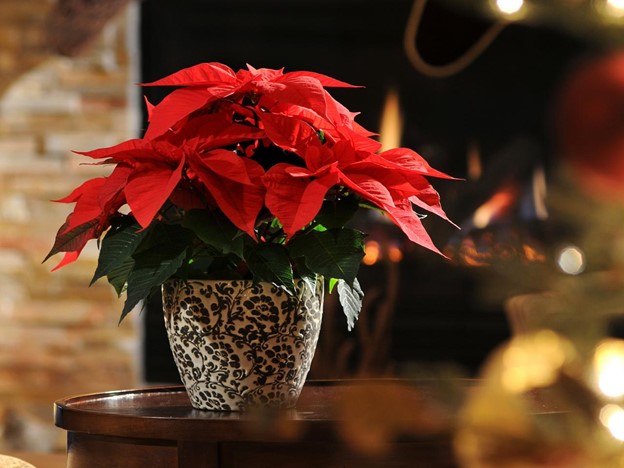Pretty Poinsettias: Caring for Them Year ‘Round

The holidays wouldn’t seem complete without poinsettia plants; one of the most popular holiday flowers. While you may be familiar with the gorgeous red blooms of poinsettias, these days you can find them in an array of beautiful colors. And you may not know this, but they aren’t actually flowers. They are modified leaves called "bracts". The inviting bracts attract insects to the tiny yellow flowers in their centers. Poinsettias need a little TLC to keep them in bloom throughout the holidays and beyond. While you might just buy new ones every year, it IS possible to get them to rebloom the next season. 13 Christmas Plants Perfect for a Magical, Indoor Holiday Garden
How to Care for a Poinsettia:
- Be sure to provide enough light for your poinsettia. Place it near a window that gets a lot of sunlight. South, east, or west-facing windows are all better than a north-facing window. They are tropical plants and will soak in all the direct sunlight they can get.
- Use a loose, well-draining, peat-based potting soil.
- When the surface of the soil feels dry to the touch, it’s time to water your poinsettia. Water until it drains out the bottom of the pot, but do not OVER water. The plant should not sit in water. So, make sure the pot has a hole in the bottom for drainage. And if your poinsettia is in the typical foil wrapping, remove the foil so that water can drain. If your plant sits in water, the roots will rot.
- Poinsettias, being tropical plants, like mild temperatures. For them to stay in bloom as long as possible, maintain a temperature of 65-75 F during the day. Dropping the temp to about 60 F at night won’t harm them, but cold drafts, allowing the leaves to touch a cold window, and lack of decent light can result in premature leaf drop. If you live in a dry climate, you may need to water your poinsettia more often, but you should never water it every day.
- You will not need to fertilize your poinsettias during the blooming period. But if you plan to keep the plant all year, begin fertilizing it in spring at half-strength when there is no growth. Feed every three to four weeks.
With the right care, your poinsettia will stay healthy and robust throughout the holiday season. They will need enough sun, warmth, and water to achieve the ideal seasonal color.
If you wish to keep your poinsettia through more than one season and force reblooming, follow these steps. Getting a poinsettia to rebloom is not an easy process, so don't be disheartened if you don't have success your first try.
- January – March: Continue watering poinsettia when the surface of the soil is dry.
- April: Beginning on April 1, slowly decrease the amount you water, allowing the soil to get dry between waterings. Watch that the stem does not begin to shrivel. This is a sign of stress and indicates the plant is dying. After a couple of weeks, when the plant has acclimated to the drying process, move it to a cool spot, such as a basement or garage. You will want to keep it at a temp of about 60 F. Now is also the time to prune stems back four to six inches to promote new growth.
- May: Around mid-May cut stems back to about four inches and repot in a slightly larger pot with new potting soil. Water it regularly. Place the poinsettia by a window that gets lots of natural sunlight and go back to keeping it in temps between 65 F and 75 F. Water whenever the surface feels dry and watch for new growth. As soon as you see new growth, begin to fertilize every two weeks with a Complete Fertilizer. Be sure to follow the fertilizer label instructions.
- June: Move the poinsettia outside. Make sure it is in a partially shaded location and maintain your schedule of watering and fertilizing.
- July: Early in July, Pinch back each stem by approximately 1 inch. This will encourage a burly, well-branched plant. A poinsettia that is left unpinched will grow tall and spindly.
- August: The stems should have branched and leafed out by mid-August. Once again, pinch or cut the new stems, leaving three to four leaves on each one. Bring you poinsettia back indoors and place by your brightest window again. Keep watering and fertilizing!
- September: Continue watering and fertilizing. Be sure to keep the temperature above 65 F.
- October: Poinsettias are Short-Day Plants, which means their bud set is affected by the length of daylight. To rebloom, they need about 10 weeks with 12 hours or less of sunlight per day. It will be necessary to artificially create these conditions and you must be diligent in doing so. Starting on October 1st, keep your plant in complete darkness between 5:00 PM and 8:00 AM. Any exposure to light during those hours will delay blooming. You can use a box or fabric to cover the plant and keep sunlight out. Move your poinsettia back to its sunny window during the daytime and continue watering and fertilizing.
- November: You can discontinue the darkness treatment around the last week of November and allow your poinsettia to remain in its sunny window. You should start to see flower buds at this point.
- December: Discontinue fertilizing around December 15th. Keep watering and treat your poinsettia the way you did when you first brought it home in bloom. Hopefully, if all has gone well, you will have a pretty poinsettia back in bloom for another holiday season!
If you are in the market to buy or sell a home, let Sandra Nickel and her Hat Team of Professionals assist you with all your real estate needs! Call them today at 334-834-1500!
Photo Credit: diynetwork.com










